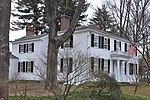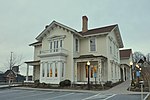Jehiel Cochran House
Federal architecture in MassachusettsGreek Revival houses in MassachusettsHouses in Andover, MassachusettsHouses on the National Register of Historic Places in Essex County, MassachusettsNational Register of Historic Places in Andover, Massachusetts

The Jehiel Cochran House (also known locally as Brickhaven) is a historic house at 65 Burnham Road in Andover, Massachusetts. It is listed on the National Register of Historic Places and Massachusetts cultural inventory records at 63 Burnham Road, but by the Andover Historical Society at 65 Burnham Road. The house, built in the 1830s, is locally distinctive for its use of brick, and for its association with the Jehiel Cochran, the brickyard owner who built it. It was listed on the National Register in 1982.
Excerpt from the Wikipedia article Jehiel Cochran House (License: CC BY-SA 3.0, Authors, Images).Jehiel Cochran House
Burnham Road,
Geographical coordinates (GPS) Address Nearby Places Show on map
Geographical coordinates (GPS)
| Latitude | Longitude |
|---|---|
| N 42.669444444444 ° | E -71.142222222222 ° |
Address
Burnham Road 79
01810
Massachusetts, United States
Open on Google Maps











